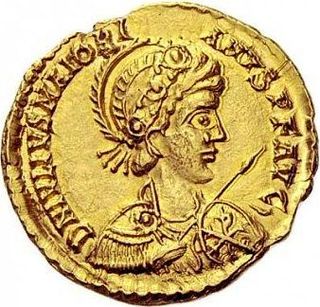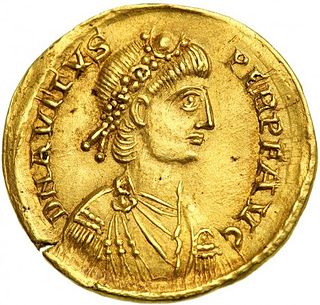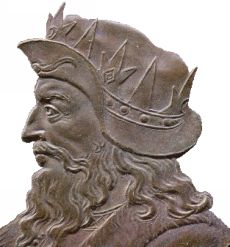
Year 448 (CDXLVIII) was a leap year starting on Thursday of the Julian calendar. At the time, it was known as the Year of the Consulship of Praetextatus and Zeno. The denomination 448 for this year has been used since the early medieval period, when the Anno Domini calendar era became the prevalent method in Europe for naming years.
Merovech was the ancestor of the Merovingian dynasty. He was reportedly a king of the Salian Franks, but records of his existence are mixed with legend and myth. The most important written source, Gregory of Tours, recorded that Merovech was said to be descended from Chlodio, a roughly contemporary Frankish warlord who pushed from the Silva Carbonaria in modern central Belgium as far south as the Somme, north of Paris in modern-day France. His supposed descendants, the kings Childeric I and Clovis I, are the first well-attested Merovingians.

Ricimer was a Romanized Germanic general, who ruled the remaining territory of the Western Roman Empire from 456 after defeating Avitus, until his death in 472, with a brief interlude in which he contested power with Procopius Anthemius. Deriving his power from his position as magister militum of the Western Empire, Ricimer exercised political control through a series of puppet emperors. Ricimer's death led to unrest across Italy and the establishment of a Germanic kingdom on the Italian Peninsula.

Majorian was Western Roman emperor from 457 to 461. A prominent commander in the Western military, Majorian deposed Avitus in 457 with the aid of his ally Ricimer at the Battle of Placentia. Possessing little more than Italy and Dalmatia, as well as some territory in Hispania and northern Gaul, Majorian campaigned rigorously for three years against the Empire's enemies. In 461, he was murdered at Dertona in a conspiracy, and his successors until the fall of the Empire in 476 were puppets either of barbarian generals or the Eastern Roman court.

Flavius Aetius was a Roman general and statesman of the closing period of the Western Roman Empire. He was a military commander and the most influential man in the Empire for two decades (433–454). He managed policy in regard to the attacks of barbarian federates settled throughout the West. Notably, he mustered a large Roman and allied (foederati) army in the Battle of the Catalaunian Plains, ending an invasion of Gaul by Attila in 451, though the Hun and his subjugated allies still managed to invade Italy the following year, an incursion best remembered for the Sack of Aquileia and the intercession of Pope Leo I. In 454, he was assassinated by the emperor Valentinian III.

Eparchius Avitus was Roman emperor of the Western Empire from July 455 to October 456. He was a senator of Gallic extraction and a high-ranking officer both in the civil and military administration, as well as Bishop of Piacenza.

Gaius Sollius Modestus Apollinaris Sidonius, better known as Sidonius Apollinaris, was a poet, diplomat, and bishop. Born into the Gallo-Roman aristocracy, he was son-in-law to Emperor Avitus and was appointed Urban prefect of Rome by Emperor Anthemius in 468. In 469 he was appointed Bishop of Clermont and he led the defence of the city from Euric, King of the Visigoths, from 473 to 475. He retained his position as bishop after the city's conquest, until his death in the 480s. He is venerated as a saint in the Catholic church, the Orthodox Church, and the True Orthodox Church, with his feast day on 21 August.
Aegidius was the ruler of the short-lived Kingdom of Soissons from 461 to 464/465. Before his ascension he was an ardent supporter of the Western Roman emperor Majorian, who appointed him magister militum per Gallias in 458. After the general Ricimer assassinated Majorian and replaced him with Emperor Libius Severus, Aegidius rebelled and began governing his Gallic territory as an independent kingdom. He may have pledged his allegiance to the Eastern Roman emperor Leo I.

Chlodio, also Clodio, Clodius, Clodion, Cloio or Chlogio, was a Frankish king who attacked and then apparently ruled Roman-inhabited lands around Cambrai and Tournai, near the modern border of Belgium and France. He is known from very few records.

The Salian Franks, also called the Salians, were a northwestern subgroup of the early Franks who appear in the historical record in the fourth and fifth centuries. They lived west of the Lower Rhine in what was then the Roman Empire and today the Netherlands and Belgium.

Marcellinus was a Roman general and patrician who ruled over the region of Dalmatia in the Western Roman Empire and held sway with the army there from 454 until his death. Governing Dalmatia both independently from, and under, six Emperors during the twilight of the Western Empire, Marcellinus proved to be an able administrator and military personality with sources making reference that he ruled justly and well and kept Dalmatia independent of the emperor and of barbarian rulers.

Theodoric I was the king of the Visigoths from 418 to 451. Theodoric is famous for his part in stopping Attila the Hun at the Battle of the Catalaunian Plains in 451, where he was killed.

The Gothic War (436–439) was a military conflict between the Gothic foederati and the Western Roman Empire under Emperor Valentinian III. It occurred primarily in the Gallic provinces from 436 to 439. The key figures involved were the Gothic leader Theodoric I and the Roman army's commander-in-chief, Aetius. Contemporary sources characterize this conflict as a war. Additionally, there were uprisings of the Burgundians and the Bagaudae during the same period.

The Gothic War in Spain of 456 was a military operation of the Visigoths commissioned by the West Roman emperor Avitus. This operation consisted of an extensive campaign aimed at reclaiming the Spanish provinces of Lusitania and Betica that were in the hands of the Suebi and threatened Roman power in the provinces of Cartaginensis and Tarraconensis. The main players in this war were Theoderic II who led the army of the Visigoths and Rechiar the king of the Suebi. The Visigothic army was supported by Franks and Burgundian auxiliary troops.

The Gothic War of 457–458 was a military conflict between the Visigoths of Theoderic II against the Western Roman Empire of Emperor Majorian. The war began in 457 with a revolt of the Goths in Aquitania that pushed aside Roman authority, followed by an aggressive conquest in the adjacent Septimania aimed at area expansion. The war ended with a Roman victory over the Goths in the Battle of Arles in 458.

The Roman Civil War of 456 was a civil war fought in the Western Roman Empire during the second half of 456 AD.

The Frankish War was a short military conflict between the Frankish people and the West Roman Empire under Emperor Valentinian III. In this conflict, it can only be said with certainty that the Roman general Aetius was involved in it. The presence of King Chlodio of the Salians as captain of the Franks is an assumption and is not confirmed by contemporary sources. The war ended in a Roman victory.

The Frankish War of 431–432 was a short war between the Franks and the Western Roman Empire under Emperor Valentinian III. Like the previous Frankish war, the Roman army was led by the Roman general Aetius and the participation of Chlodio, the king of the Salian Franks is uncertain. The war ended in a Roman victory after which both sides agreed to a peace treaty.

Frankish War (441–446) was a multi-year military conflict in the provinces of Germania II and Belgica I during the reign of Emperor Valentinian. In addition to the Western Roman Empire, the two tribal associations of the Franks were involved: the Salian Franks and the Ripuarian Franks. The main players in this conflict were Flavius Aetius and Chlodio.













